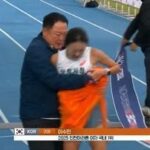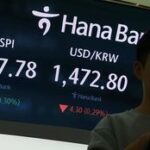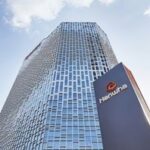
In 1994, tensions on the Korean Peninsula escalated dramatically during inter-Korean special envoy talks, primarily due to incendiary comments from North Korean representative Park Young Soo. Threatening to turn Seoul into a “sea of fire,” Park underscored North Korea’s confidence in its military capabilities, particularly its long-range artillery positioned near the DMZ.
Military intelligence confirms that North Korea has strategically placed over 330 long-range artillery units capable of targeting Seoul with significant precision. Notable among these are the 170mm self-propelled guns and 240mm multiple rocket launchers stationed in areas like Woljeong-ri and Pyeonghwa-ri within the Kaesong region. These artillery pieces can reach distances up to 54 km (33.6 miles) and beyond 60 km (37.3 miles), respectively, posing a direct threat to the Seoul metropolitan area.
Recent online images, which have stirred controversy, appear to show North Korea’s M-1989 self-propelled guns—central to the aforementioned “sea of fire” threat—being transported from Russia. This development is particularly alarming as the M-1989, also known as the Koksan or Juche gun, is a significant component of North Korea’s artillery capabilities.
According to reports by the military and conflict news account Status-6 on X, Russian channels have released photos showing North Korea’s M-1978/1989 Koksan 170mm self-propelled guns being transported by rail. Background analysis suggests the firearms are located in Krasnoyarsk, central Russia.
The Juche gun, designated M-1989 by NATO, represents an upgrade to the older M-1978 Koksan 170mm self-propelled gun. It utilizes a chassis modified from North Korea’s VTT-323 armored personnel carrier and is locally known as the “Victory Horse” or “New Armored Vehicle.”
The M-1989 made its public debut in a North Korean military parade, where it was revealed under the name “Juche,” commonly referred to as the Juche self-propelled gun or Juche artillery. North Korea developed this weapon by mounting a 170mm howitzer on a modified Soviet T-54/55 or Type 59 tank chassis, aiming to threaten the Seoul metropolitan area with long-range fire.

The effectiveness of the 170mm self-propelled gun was notably demonstrated during the Iran-Iraq War. Despite facing U.S. sanctions, Iran turned to North Korea for arms, acquiring 36 units of the Koksan gun. While it sacrifices some capabilities for extended range, its reach proved successful in combat, albeit limited to firing one to two rounds every five minutes.
As the conflict along the Tigris River stagnated, the Koksan gun’s ability to deliver accurate long-range fire became increasingly valuable. Iraqi forces even attempted to operate captured Koksan guns, highlighting their impact on the battlefield.
To manage the shortage of 170mm shells, Iraq repurposed Soviet 180mm S-23 artillery, modifying T-55-based BLG-60 bridge-laying tanks to create its artillery. This led to an unusual scenario in which Iran and Iraq engaged each other with North Korean-designed self-propelled guns.
Critical flaw: 30-minute firing preparation time
The critical vulnerabilities of North Korea’s 170mm self-propelled guns, notably the Koksan, underscore significant operational limitations regarding deployment speed and fire rate, considerably diminishing their threat level to allied forces.
Extended Preparation Time: The Koksan’s protracted 30-minute preparation time for firing presents a significant tactical disadvantage. This duration is on par with the setup time required for the colossal 800mm Gustav railway gun used during World War II. To put this into perspective, during the 2010 bombardment of Yeonpyeong Island, South Korean K-9 Thunder self-propelled guns faced criticism for an 8-minute delay in responding. The lengthy setup time for the Koksan means that these artillery units could be easily targeted and neutralized by counter-battery fire from allied forces if detected by satellite or aerial reconnaissance before they can even commence firing.
Low Fire Rate: Further exacerbating its operational shortcomings is the Koksan’s painfully slow fire rate of only one to two rounds every five minutes, starkly contrasting to more modern artillery systems. For comparison, the German SturmTiger, equipped with massive 380mm shells, could fire approximately one round per minute. Similarly, the Soviet 420mm self-propelled 2B1 Oka managed a comparable rate, highlighting Koksan’s outdated performance metrics.
Comparative Analysis with Western Systems: When juxtaposed with Western artillery, the deficiencies of the Koksan become even more pronounced. Western counterparts like the M107 and M110 self-propelled guns, equipped with semi-automatic loaders, can sustain a firing rate of one round per minute during regular operation and accelerate to two rounds per minute during intense combat scenarios. This capability vastly outpaces the Koksan’s operational effectiveness.
Construction and Accuracy Issues: The Koksan gun’s construction has also been critiqued for its rudimentary design. The artillery piece involves Soviet-era 170mm barrels that have been crudely welded together and mounted on outdated T-55 or Type 59 tank chassis. This haphazard modification not only affects the durability but also significantly impairs the accuracy of the guns, further limiting their effectiveness in combat situations.
The combination of these critical flaws — particularly the extended preparation time and the low rate of fire — means that in a potential conflict, the Koksan’s ability to engage enemy targets effectively is highly questionable. Without the capability to deliver rapid and precise fire, the North Korean long-range artillery’s role in modern warfare, especially against well-equipped and technologically advanced adversaries like U.S. and South Korean forces, is severely compromised.















Most Commented